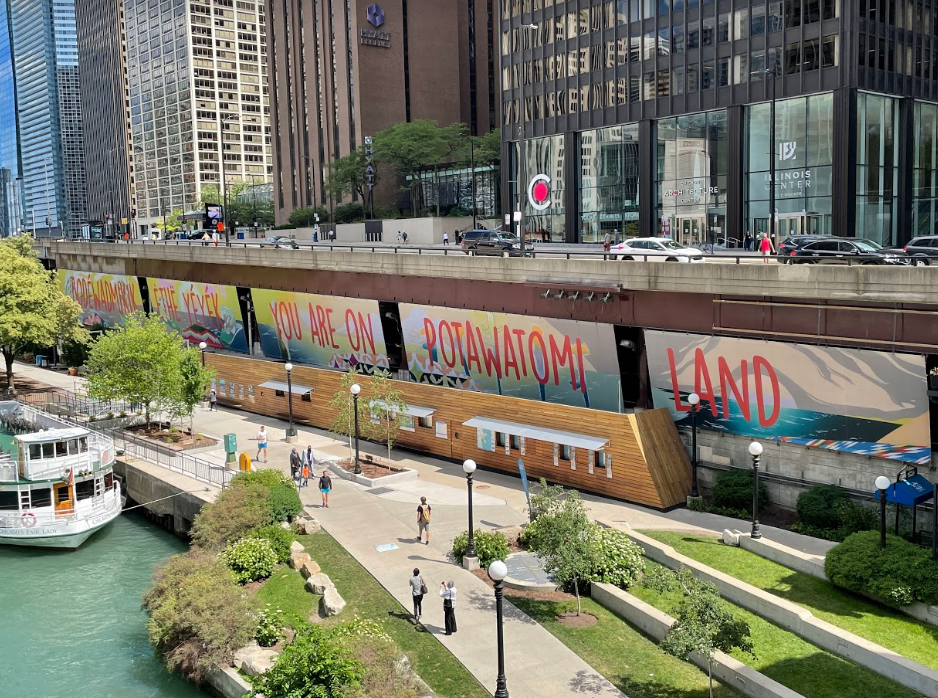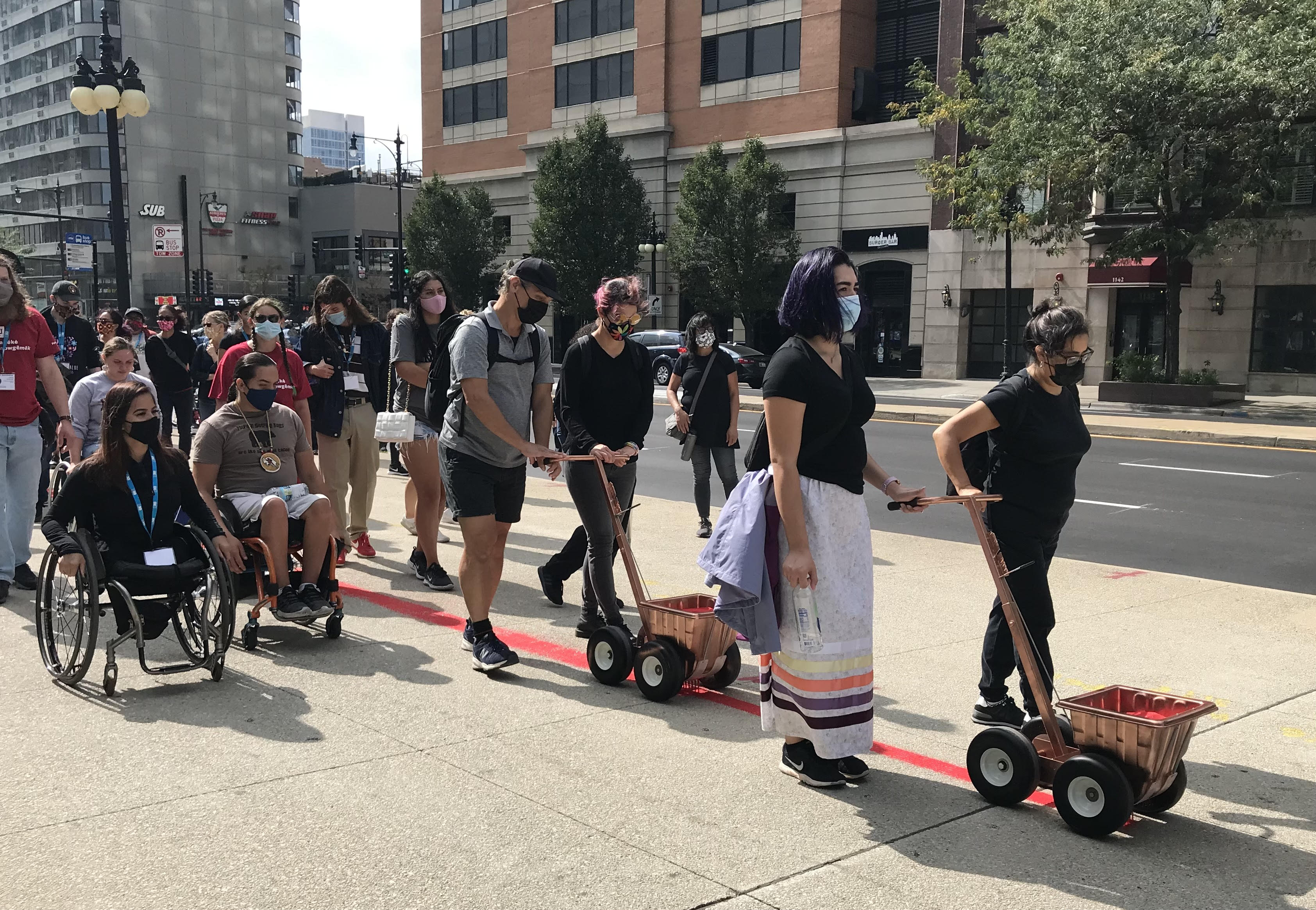
- Details
- By Levi Rickert
This holiday weekend, I have taken time to reflect on Native American Heritage Month. One observation is that there have been a noticeable number of television programs and events highlighting Native Americans this November in comparison to previous years.
Of course, Native Americans believe they should be celebrated every month. I agree because, this year in particular, I have celebrated being Potawatomi in a special way.
Want more Native News? Get the free daily newsletter today.
It began this past Father’s Day when I took an Amtrak train from Michigan to Chicago’s Union Station to see my three adult children who reside in the Windy City. I was excited to see them as I had not done so in over a year due to the COVID-19 pandemic.
As the Lyft moved along Chicago’s Lower Wacker Drive—out of my peripheral vision, I saw the word POTAWATOMI—in reverse—painted on a large canvas. I turned my head to confirm what I thought I saw. Sure enough, it read Potawatomi.
Once I arrived at my son’s place, I told my daughter with excitement in my voice about seeing the word “Potawatomi” from the car. She provided context as she smiled and said, “My friend Andrea Carlson painted a mural on the Chicago Waterfront that says, ‘You Are on Potawatomi Land.’”
Carlson’s work contains the phrase “Bodéwadmikik ėthë yéyék” in Potawatomi language and then the English version. The mural consists of five banners 15 feet high and 266 feet long.
It was installed in early June and will be on display for at least the next two years. The project was created in response to last year’s protests against the Columbus statues and aims to rectify monuments throughout the city.
Native News Online reporter Monica Whitepigeon interviewed Carlson, an Ojibwe artist from the Grand Portage Band of Lake Superior Chippewa, who moved to Chicago from Minneapolis five years ago.
She explained the meaning of her message: a portion of Chicago is on unceded Potawatomi territory
A little-known fact is after Chicago's Great Fire of 1871, when Mrs. O’Leary’s cow accidentally knocked over a lantern that burned the city, the debris was pushed into Lake Michigan, creating a landfill from the current lake’s boundary to present day Michigan Avenue. This increased land infringed on the water rights of the Potawatomi, which through the Treaty of Greenville of 1795, (which one of my ancestors, Wahbememe signed), granted a portion of Lake Michigan, south of the Grand River in Michigan to south of the Milwaukee River in Wisconsin, was Potawatomi.
So, the land between present day Michigan Avenue and the current boundary of a portion of Chicago, was technically unceded.
In 1914, eight Pokagon Potawatomi filed a lawsuit, Williams v. City of Chicago, 242 U.S. 434, in the U.S. District Court in Northern Illinois. Their lawsuit cited the Treaty of Greenville. When the Potawatomi were forced westward during the Trail of Death of 1837, the land was lost, but remained unceded.
The case went to the U.S. Supreme Court. The highest court of the land decided that the Potawatomi “abandoned” the territory and decided against the eight plaintiffs.
Carlson told Native News Online in her interview:
“Another reason I chose those words for the banner, is the current #LandBack movement. This movement of rematriating land means that we as Nativempeople must start thinking of these historic cases. The Pokagon Band came back for the land. They had used their resources to sue and made a case for the lakefront on behalf of all Potawatomi people. I wanted my piece to bow to those Potawatomi ancestors whose hearts were broken with that decision. I want to make sure that Potawatomi people know that they are home when they see this work.”
Support news coverage that inspires, uplifts, and informs Native Americans.
On the first Saturday in October, I returned to Chicago to cover an event organized by Whose Lakefront Planning Group at the invitation of organizer JeeYeun Lee. Among the couple hundred people were Pokagon Potawatomi Band tribal citizens, other Potawatomi, other tribal citizens from various parts of the United States, and allies. They gathered to make a statement about the 1917 Supreme Court ruling.
And, what a statement they made. They used two line-striping machines with bright red sand to mark the eastern sidewalk of Michigan Avenue between Roosevelt Street on the south to the Chicago River on the north that was unceded Potawatomi land.
The red sand demarcation gave the term relining a new meaning for me.

To me, a Potawatomi man, it was a reminder of what was lost. Among the bustling crowd of tourists and shoppers on a Saturday afternoon in the nation’s third largest city, I looked out to Grant Park and knew the Supreme Court got it wrong. The Potawatomi were forced out of their land. They did not abandon it.
The event ended with some speeches and dancing.
Afterward, I stood across the Chicago River and saw Carlson’s mural. It read “Bodéwadmikik ėthë yéyék” in Potawatomi, “You Are on Potawatomi Land” in English.
The pride of being Potawatomi as I stood there remains with me now and will remain a year-round feeling.
As part of celebrating who we are, we must support the #LandBack movement, its artwork and its purpose. While I am lifted by the increased attention on Native Americans, the issue of stolen land and phony Supreme Court decisions, we must ensure that these celebrations and added attention are not just happening in November, but year-round.
More Stories Like This
Colorado cannot heal until it confronts Sand Creek honestlyNative American Mothers Deserve to Live
Technology Rooted in Tradition is Strengthening Cherokee Nation
The Lumbee Tribe of North Carolina: #575
Tribes Do Not Need a Greenlight to Build Renewable Energy
Help us defend tribal sovereignty.
At Native News Online, our mission is rooted in telling the stories that strengthen sovereignty and uplift Indigenous voices — not just at year’s end, but every single day.
Because of your generosity last year, we were able to keep our reporters on the ground in tribal communities, at national gatherings and in the halls of Congress — covering the issues that matter most to Indian Country: sovereignty, culture, education, health and economic opportunity.
That support sustained us through a tough year in 2025. Now, as we look to the year ahead, we need your help right now to ensure warrior journalism remains strong — reporting that defends tribal sovereignty, amplifies Native truth, and holds power accountable.
 The stakes couldn't be higher. Your support keeps Native voices heard, Native stories told and Native sovereignty defended.
The stakes couldn't be higher. Your support keeps Native voices heard, Native stories told and Native sovereignty defended.
Stand with Warrior Journalism today.
Levi Rickert (Potawatomi), Editor & Publisher

